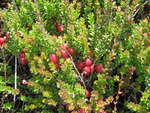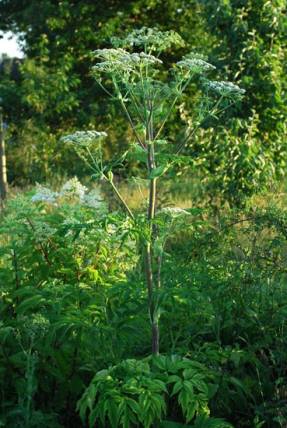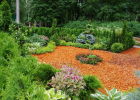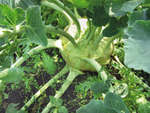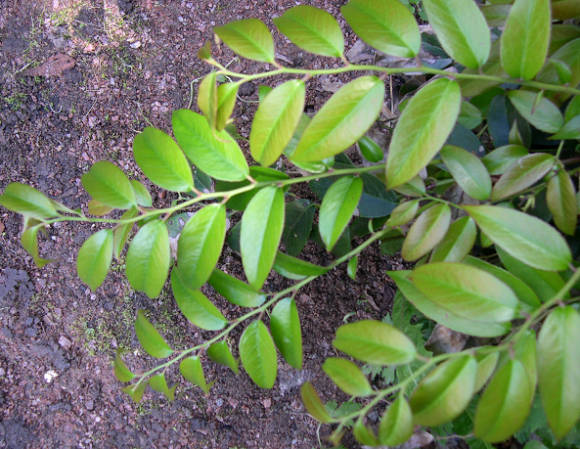The characteristic and most famous representative of the Guava genus (Psidium) is the common guava, or psidium guayava(Psidium guajava), or simply guava... This is an evergreen shrub or a small beautiful tree about 10 m, sometimes grows up to 20 m, originally from tropical America, perhaps the range once spread from Mexico to Peru. Quite a long time ago, guayava was introduced to India, where it was successfully naturalized, now it is grown throughout the East, it also grows on the Mediterranean coast of France and Algeria, in the USA it is grown in Southern California and Florida. The life of the plant is short, only about 40 years.
 |
 |
 |
The bark of the trunk is smooth, light brown, exfoliates with age, exposing the green areas of the trunk. Young branches are tetrahedral. Leaves are opposite, 5-15 cm long and 3-5 cm wide, elliptical, pointed, with a characteristic uneven surface and distinct transverse veins, matte, pubescent below, fragrant when rubbed. Flowers appear on young growths, bisexual, white, with numerous stamens, calyx 4-5 lobes, usually located singly or in pairs in the leaf axils. P. guayava is capable of blooming several times a year. It usually produces one large crop and several smaller ones. Fruits are spherical, ovate or pear-shaped, up to 10 cm, whitish-yellow or pale pink, sweet and sour, with a pronounced musky aroma, fleshy, polyspermous.
The fruits are valued, in addition to their high taste, for their high content of vitamin C, which in guava fruits is several times more than in citrus fruits, red-colored fruits contain a large amount of beta-carotene, fruits are also rich in B vitamins and vitamin P, very aromatic ... They are used raw and jams, for flavoring desserts, for making juices, cocktails, sauces, salads and drinks. Unripe fruits are rich in pectin.
Guava juice is used to treat heart disease and asthma, the fruit is used for diarrhea and diseases of the bladder, in the treatment of diseases in the throat. The leaves and bark are rich in tannins, the bark is used to tan leather, and a black dye is released from the leaves. Tea from the bark and leaves helps with digestive disorders, in the treatment of dysentery. The leaves contain substances with antibacterial and anticancer activity. The dense wood is used to make tools, its aroma is unusually saturating the meat when smoking and barbecuing.
Psidium guayava prefers a dry tropical climate, is not picky about soils, can grow both on heavy clays and on sands, tolerates soil acidity from pH 4.5 to pH 9.4, is relatively salt-resistant, tolerates a short drought and tolerates some waterlogging, although it prefers moist, well-drained soil. Loves full sun, although it can grow in a little shade. It grows poorly at low summer temperatures, does not tolerate extreme heat, the minimum temperature is +5 degrees, adult plants can tolerate short frosts of 1-2 degrees, but they are still a serious stress for plants.
Unpretentiousness to the composition of the soil and its moisture makes this species quite aggressive in countries with a warm climate, where it is able to form dense thickets, displace native species, and seize pastures. Initially cultivated in gardens, it spreads rapidly and naturalizes by dispersing seeds from fruits eaten by birds and animals. P. guayava is recognized as an invasive species in the Galapagos Islands, Hawaii, New Zealand and South Africa, and poses specific problems in the Marquesas Islands, New Caledonia and Fiji.
Guayava easily propagates with fresh seeds; when grown on plantations, the method of grafting and grafting is used to preserve the variety, it can give root shoots. Seedlings bloom at 3-4 years old, the peak of fruiting occurs at the age of 15-25 years.
There are several varieties selected during the cultivation process. They differ in the color of the peel and pulp, the shape and size of the fruit, and taste. The two previously described species guava pear-bearing(Psidium pyriferum) with a pear-shaped fruit and apple guava(Psidium pomiferum) with rounded fruits are now considered a subspecies of common guava. Some varieties are sold as Guava guinea(Psidium quineense), although this is a separate species, like others, for example, aromatic guava(Psidium aromaticum).
Care and maintenance

Psidium guayava is capable of bearing fruit in small volumes of soil and is often grown as a container or potted fruit plant. But it develops especially well in ground greenhouses. Growth is quite fast, the annual growth is about 30 cm, and the plant can develop over the years into not a small tree.
The plant tolerates pruning and shaping well, but the field usually does not give this strong branching (in India and East Asian countries it is used to create bonsai).
The main difficulty in keeping a house in the temperate zone is the lack of light in the winter and the need to provide the plant with a cool, light wintering, at +12 ... + 150C. Guayava prefers illuminated windows of east, south and west orientation, in summer it is advisable to take out into the open air in the sun. When growing in a pot, care should be taken to ensure that the roots do not overheat in the sun. The rest of the psidium is undemanding, tolerates a short overdrying. It should be noted that brown spots often appear on the leaves, this slightly spoils the appearance of the plant. It is affected by mealybugs, scale insects.
On measures to combat these insects - in article Houseplant pests and control measures.

Guayava vulgaris is easily propagated by fresh seeds. Having bought a ripe guava, you can eat its pulp by removing the seeds for sowing. By placing them in a container with soil (for example, soil for myrtle) and arranging a greenhouse, you will receive seedlings in 4-6 weeks. Seedlings 10 cm high can be planted in separate pots and grown in a warm, sunny place. Young plants like abundant watering and showers, but it is necessary to lightly dry the soil between waterings. The beginning of flowering and fruiting can occur in 2-8 years (on average, 2-3), and the plant has reached a meter height by this time.
In room culture, guavas are not very readily cuttings, only in greenhouses with lower heating and the use of root formers. However, the waiting period for rooting can last from 1 to 2 months, and its success rate is only 2%. It may be preferable to use the air lay method, although it is even more time-consuming.
More about the technology of cuttings - in the article Cutting indoor plants at home.
In conclusion, we emphasize that for this tropical plant, warm, light and humid conditions are the ideal environment. Therefore, it will feel good in a subtropical winter garden, and in the summer it will respond gratefully to moving to the veranda, to the greenhouse, to the glazed gazebo or just to the sun in the open air.

